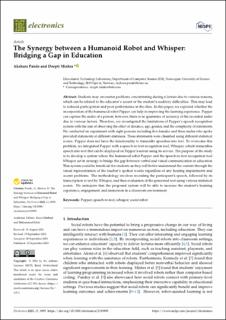| dc.contributor.author | Pande, Akshara | |
| dc.contributor.author | Mishra, Deepti | |
| dc.date.accessioned | 2023-11-15T13:51:51Z | |
| dc.date.available | 2023-11-15T13:51:51Z | |
| dc.date.created | 2023-10-01T11:28:11Z | |
| dc.date.issued | 2023 | |
| dc.identifier.citation | Electronics. 2023, 12 (19), . | en_US |
| dc.identifier.issn | 2079-9292 | |
| dc.identifier.uri | https://hdl.handle.net/11250/3102762 | |
| dc.description.abstract | Students may encounter problems concentrating during a lecture due to various reasons, which can be related to the educator’s accent or the student’s auditory difficulties. This may lead to reduced participation and poor performance in the class. In this paper, we explored whether the incorporation of the humanoid robot Pepper can help in improving the learning experience. Pepper can capture the audio of a person; however, there is no guarantee of accuracy of the recorded audio due to various factors. Therefore, we investigated the limitations of Pepper’s speech recognition system with the aim of observing the effect of distance, age, gender, and the complexity of statements. We conducted an experiment with eight persons including five females and three males who spoke provided statements at different distances. These statements were classified using different statistical scores. Pepper does not have the functionality to transcribe speeches into text. To overcome this problem, we integrated Pepper with a speech-to-text recognition tool, Whisper, which transcribes speech into text that can be displayed on Pepper’s screen using its service. The purpose of the study is to develop a system where the humanoid robot Pepper and the speech-to-text recognition tool Whisper act in synergy to bridge the gap between verbal and visual communication in education. This system could be beneficial for students as they will better understand the content through the visual representation of the teacher’s spoken words regardless of any hearing impairments and accent problems. The methodology involves recording the participant’s speech, followed by its transcription to text by Whisper, and then evaluation of the generated text using various statistical scores. We anticipate that the proposed system will be able to increase the student’s learning experience, engagement, and immersion in a classroom environment. | en_US |
| dc.language.iso | eng | en_US |
| dc.publisher | MDPI | en_US |
| dc.rights | Navngivelse 4.0 Internasjonal | * |
| dc.rights.uri | http://creativecommons.org/licenses/by/4.0/deed.no | * |
| dc.title | The Synergy between a Humanoid Robot and Whisper: Bridging a Gap in Education | en_US |
| dc.title.alternative | The Synergy between a Humanoid Robot and Whisper: Bridging a Gap in Education | en_US |
| dc.type | Journal article | en_US |
| dc.type | Peer reviewed | en_US |
| dc.description.version | publishedVersion | en_US |
| dc.source.pagenumber | 16 | en_US |
| dc.source.volume | 12 | en_US |
| dc.source.journal | Electronics | en_US |
| dc.source.issue | 19 | en_US |
| dc.identifier.doi | 10.3390/electronics12193995 | |
| dc.identifier.cristin | 2180653 | |
| cristin.ispublished | true | |
| cristin.fulltext | original | |
| cristin.qualitycode | 1 | |

